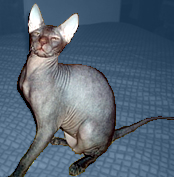|
The Scratching Post
Donskoy

The Donskoy (aka Russian Bald Cat) has a very unique appearance. Though very similar to the Sphynx, they are different breeds and should not be confused. Just imagine a cat with a head like "ET" with long ears and almond-shaped eyes, the scruff of a giraffe, the small belly of a piglet, small webbed toes, the tail of a rat and a working thumb. Put this animal into a leather or suede coat with lots of wrinkles and you have the Russian Donskoy. This breed has elongated webbed fingers and is able to seize things with their tiny monkey-like hands. Their toes are very similar to human toes.
|
|
Temperament
|
The Donskoy is smart, waggish, lively and behave more like children than cats. They can sometimes take on the personality of their owners. They are wise and are very tender-hearted. This breed is very friendly with anyone they encounter and are easily trained to follow voice commands. Because of their high body temperature, Donskoys need more food than other breeds. They are connoisseurs of special cuisine, always appreciating something new including potatoes, fresh tomatoes, pickled cabbage, watermelon, apples and kiwi. They even love spaghetti, corn and green peas. Dons may have a rather selective attitude towards other cats and may snarl, but will be slow to bite or show aggression towards humans. This enchanting breed is jovial, does wonderful tricks and has a precious and lovable nature.
|
|
Height, Weight
|
6-11 lbs.
|
|
Health Problems
|
The Donskoy possess high immunity to most diseases, but should be kept away from drafty places.
|
|
Living Conditions
|
It is recommended that you keep your Donskoy indoors at all times. Hairless cats do not possess the same protection as other cats against sharp objects and temperature fluctuations. This breed will sweat when they are hot, will sunburn and will tan.
|
|
Exercise
|
Though this breed enjoys socializing, they are able to entertain themselves by playing with their toys and utilizing a scratching post.
|
|
Life Expectancy
|
About 10-12 years
|
|
Grooming
|
This hairless breed requires no brushing; however, regular washing with a wash cloth or with baby wipes is necessary. Since they have no fur around the ears to block dust and dirt from entering them, their ears need occasional cleaning as well. They are also free from odor.
|
|
Origin
|
This breed originated from a hairless queen named Chita. The first Don appeared in the United States in 2001 at the Possom Creek Cattery. In 2003, Possom Creek offspring began to make their way across the country and can now be found from the east coast to the west coast. The Don is currently recognized by TICA.
|